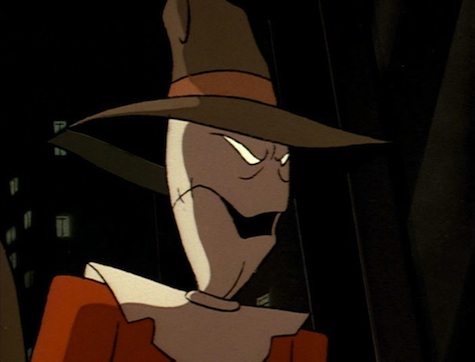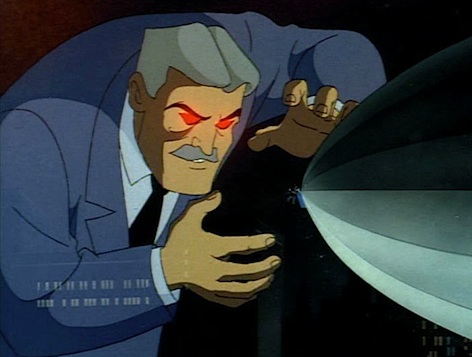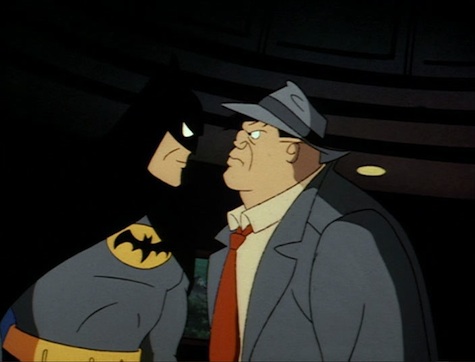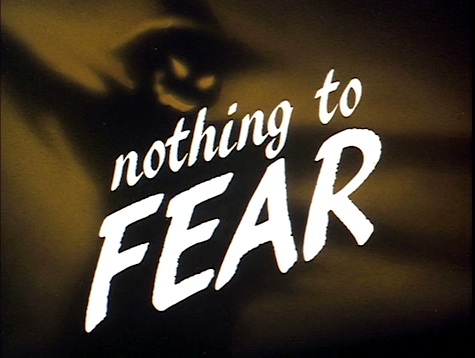“Nothing to Fear”
Written by Henry T. Gilroy & Sean Catherine Derek
Directed by Boyd Kirkland
Music by Shirley Walker
Animation Services by Dong Yang Animation Co., LTD.
Episode #003
Original Airdate – September 15th, 1992
Plot: Before he can stop the Scarecrow’s terror campaign against Gotham University, Batman must overcome his own fear of failure and horrifying visions of his late father.
And now we have the third pilot for Batman: The Animated Series, and probably the best one to tell you what the series will be like going forward. “Nothing to Fear” establishes the status quo relationship between Batman and the police, gets at the heart of why Batman does what he does, and introduces a major supervillain.
“Nothing to Fear” is the first instance of what I like to call “the Revenge Origin,” where New Costumed Villain (figure a) tries to get revenge on Powerful Authority Figure (figure b) and only Batman (figure c) can stop them. These revenge stories work because the bad guys are basically doing what Batman does, going outside the law to pursue justice. Thus, the success of these episodes depends on getting the right balance between how justified each villain is in seeking revenge and how extreme their methods are in exacting said revenge.

Unfortunately for the first time out, the Scarecrow has neither an interesting motive nor modus operandi. Jonathan Crane was fired from the university for performing sadistic fear experiments, so he’s going to perform sadistic fear experiments until the university is destroyed. This guy has one hammer and all the world looks like a nail. It doesn’t help that in his first design, he looks like an aging muppet and sounds like Niles Crane. There are hints of the more interesting villain he could be, because his use of fear as a weapon mirrors Batman’s own, and because fear can be used to manipulate people, like when he uses his fear gas to turn a crowd against Batman. Usually, however, the Scarecrow just uses his gas to knock people out.
The strength of the Scarecrow as a character is his fear toxin. First, because it causes hallucinations that allow the animators to go nuts with shrinking rooms, or faces made out of fire, or Batman turning into a winged demon, and allows Shirley Walker’s violin heavy score to set the chilling mood with allusions to Psycho and Night on Bald Mountain.
And secondly, the fear toxin reveals Bruce Wayne’s character, and that is where this episode shines. We see that Bruce’s great fear isn’t his death, but that being Batman will leave a legacy of disgrace, that he will be a failure in some way to live up to his father’s example. Whether being Batman is the correct way to honor his parents is a heady question, and this episode makes a great pseudo-pilot because it makes sure to answer. Twice.
First, Alfred assures Bruce that of course Thomas Wayne would be proud of his son, saying “I know your father would be proud of you because I’m so proud of you.” This, in a line, both cements being Batman as a morally responsible choice (as Alfred is the voice of sanity in the show) and establishes Alfred’s relationship to Bruce: Alfred is Bruce’s surrogate father. Once again, the point is made that Batman and Alfred are not just allies but a real family.

Having gotten external validation, Bruce still needs to internalize that lesson in one great moment of catharsis. Hanging from the edge of a burning zeppelin, in the face of a giant, skeletal vision of his father (God, I love this show), Batman recites lines that would forever be burned into the hearts of young Batman fans (and forever be parodied by Darkwing Duck), “I am vengeance. I am the night. I AM BATMAN!” Thus he accepts his mission, “vengeance,” his method, “the night,” and his true identity, “Batman.”
And that gets to the heart of why Batman fears that being a vigilante might be a mistake. In order to become vengeance, he has to be Batman and stop being Bruce Wayne. Bruce becomes a shell, a mask, a petty playboy. The vision of his father calls Batman “Bruce” and “a disgrace,” and in order to do his job, Batman must reject both of those titles.
(Interestingly, while the memory of his father drives the plot, this episode never establishes how Batman’s father died, or that Bruce became Batman because his parents died. Maybe that’s because everyone in America knows the origin of Batman at this point, and maybe it’s because how his parents died isn’t as important as the mere fact that they are gone, and Bruce Wayne can only guess at what they wanted for their son.)
Having established who Batman is, this episode also reestablishes his relationship to the police. He’s no longer being hunted by the cops, though he doesn’t really work with them either. Detective Bullock, who chews Batman out for withholding evidence (and Batman is totally withholding evidence), has gone from dogged pursuer to buffoonish rival who looks like a fool when Batman disappears. Basically, Bullock has gone from being Batman’s Inspector Javert to his Inspector Lestrade.

And finally, I just want to mention how great the guest voice work is on the show. Henry Polic II isn’t stellar as the Scarecrow in this episode (he gets better), but professional cranky old man Kevin McCarthy is wonderfully snarky as Scarecrow victim and Bruce Wayne chastiser Dr. Long, and special attention should also be paid to the voice work of Richard Moll, a.k.a. Bull from Night Court. He’ll get a lot more attention later, as he voices Harvey Dent, but in this episode, he’s doing fantastic yeoman’s work as the Scarecrow’s two hoods, the Bat-Computer, and especially the haunting, chilling voice of the late Thomas Wayne. It’s the vision of Thomas Wayne who’s the real antagonist here, and Moll captures that character perfectly.
Steven Padnick is a freelance writer and editor. By day. You can find more of his writing and funny pictures at padnick.tumblr.com.











As I mentioned in the “On Leather Wings” rewatch, I figure they avoided addressing the death of the Waynes because of FOX Kids’ strict censorship that banned any overt depictions or mentions of death.
Although I recognize how seminal and memorable that whole “I am vengeance, I am the night” thing was, I’ve always hated it — because Batman is not vengeance. If he were just about revenge, he would’ve killed Joe Chill and been done with it. He’d be no better than Scarecrow or Mr. Freeze or Clayface or any of his other vengeance-driven foes. What makes Batman a hero is that he’s motivated not by vengeance, but by justice. His first priority isn’t punishing the wicked, it’s protecting the innocent. It’s saving lives and trying to make sure other people don’t have to lose loved ones to crime the way he did. So I dearly wish he had said “I am justice” instead of “vengeance.” Using that word in the script completely missed the point of what Batman is all about.
Otherwise, a pretty solid episode, with a fantastic Shirley Walker score and some pretty spectacular action. Dong Yang, probably the studio that did the most B:TAS episodes (although that’s just an impression — I never actually counted), did a workmanlike job, as they usually did. I agree that the Scarecrow design doesn’t work, although I’m not particularly fond of the one that replaced it either. I much prefer the New Batman Adventures redesign of the Scarecrow as a much more grotesque and menacing figure, and Jeffrey Combs was far scarier in the role than Polic was, but unfortunately that version of the Scarecrow only appeared once. (Will this rewatch be covering TNBA as well?)
I would assume so. Despite some fanboy whining, it was the same series, just with a network hop and some retooled designs.
As far as “Vengeance” goes, one will recall this is a Batman series from the post-Frank Miller years, when it was no longer hip and groovy to portray Batman as being motivated by only pure motives, there had to be a bit of the too-smart always-angry life-denying man-child in every version of Batman depicted in any media from the late 80s and throughout the entire 90s. It wasn’t until the last five years or so that this harsh standard was relaxed and Pure Caped Crusader Batman was allowed to show up from time to time along with Messed Up Batman.
Well, chalk me up as someone who likes this design of the Scarecrow over TNBA version. (Though that one wins points for taking the Scarecrow design in a whole new, gruesome direction.) This Scarecrow really seemed to be a scarecrow, not just a guy with a noose around his neck. Of the two voices though, I definitely prefer Jeffrey Combs. Not that the two designs and voices would really work if you were to mix and match.
After watching the show many times over, I was shocked to realize (from one of the DVD commentaries?) that the show’s title credits never say the word BATMAN. The character was so iconic by that point they didn’t even need to. I suppose that’s the same reason they didn’t feel compelled to tell Batman’s origin story early on. We know it, already! Get on to the Rogue’s Gallery! The Scarecrow was the perfect vehicle for exploring Batman’s motivation though.
@3: That’s actually happened a lot with Superman and Batman adaptations. The ’88 Ruby-Spears Superman never showed the title onscreen, though it did have the announcer reciting it several times. Superman: TAS didn’t show the title onscreen either. Batman Forever‘s title logo was just the Batman emblem with “FOREVER” superimposed. And so on. It’s as if the Superman and Batman emblems have become ideograms and are actually pronounced “Superman” and “Batman.”